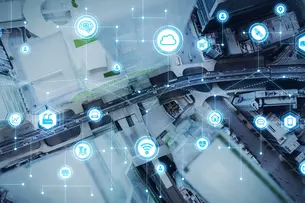- International Trade fairtransport logistic 2025Jun. 2-5, 2025
- Exhibition & Conferenceair cargo Europe 2025Jun. 2-5, 2025
- transport logistc & air cargo worldwideair cargo IndiaFeb. 14-16, 2024
Although artificial intelligence, known as AI, is on everyone's lips, it is far from having been adopted by all logistics companies. Thanks to the wide range of possible applications, however, an increasing number are exploiting its potentials. How is AI used in practice today? Let’s take a look at examples in the logistics process, in supply chain management and the challenges that ports and air freight face.
Logistics, with its widespread networks, is an ideal application area for artificial intelligence. Future production and transportation volumes, for example, can be forecast using intelligently evaluated data—for companies to use their resources more efficiently. These kinds of tasks are increasingly being supported or taken over by self-learning digital systems.

“Artificial intelligence is the ability of a machine to display human-like capabilities such as reasoning, learning, planning and creativity”—this is how the European Parliament defines AI. Using complex algorithms, it independently transfers learned procedures to new tasks, replacing programs that have to be written by humans for each individual task in rule-based if/then mode.
Logistics is another sector where the importance of this technology is growing rapidly. More than 70 percent of participants in the 2019 Bitkom study “Digitalization in logistics” believed that AI will be indispensable for logistics in ten years’ time. Yet, only just under 15 percent of companies were involved with AI. Just three years later, in October 2022, the association surveyed around 400 logistics companies:
“The logistics industry has recognized the potential that AI offers in both warehousing and transport and is making targeted use of the technology to increase efficiency, quality and productivity,” comments Bitkom CEO Dr. Bernhard Rohleder. “The logistics sector is open to and positive about digitalization, and many companies are pioneers in implementing digital technologies. By consistently using these, logistics makes a major contribution to sustainable and climate-friendly production and mobility.”
Compared to other German companies, the logistics sector plays a pioneering role. The latest figures from the ifo Institute from August 2023 confirm this: 13.3 percent of companies in Germany use AI, 9.2 percent are planning to use it and a further 36.7 percent are discussing possible application scenarios.

Forecasts from data and algorithms influenced by a wide range of parameters: What are the specific benefits of AI in logistics? A survey conducted by Inform with the trade publication Logistik heute revealed that logistics companies see the greatest potential in the following areas: ´
Fraunhofer IML uses a matrix to categorize the application of AI in logistics. In procurement & purchasing, production as well as sales & distribution, the focus is on the skills of recognizing, analyzing, planning, deciding and executing. The white paper uses practical examples to show what is already possible with “AI in logistics”:

HHLA container transporters always follow the same routes in the port terminal. AI optimizes the routes and calculates how parked containers make the best use of the space. At Burchardkai terminal, AI predicts which mode of transport is most likely to be used to deliver the boxes. As part of the COOKIE project—“Container Services Optimized by Artificial Intelligence”—AI is to detect damage to containers more quickly. At HHLA subsidiary Metrans, digital twins allow the automated inspection of more than 100 different conditions and damage to freight wagons.
No human being is able to find the mathematical optimum from the multitude of time, route and resource combinations. Hence, AI's main goal and added value is the self-learning supply chain. The advantage: it prevents products from coming out of production when there are no trucks available for transportation, which would keep customers waiting and jeopardize the company's goals. However, progress can only work without a silo mindset and rigid functional boundaries.
The volume of air freight has increased due to the combination of time-critical or high-value goods and global e-commerce. The peak value was 63.3 million metric tons in 2018. Over the past three years, volumes have been declining. In 2023, the volume was 57.8 million metric tons. For fast and safe handling, AI automates manual processes during freight loading on the ground.
This important topic was also covered at the Air Cargo Conference at transport logistic 2023 under the banner “Future of freight—the digital imperative?” The air cargo experts’ presentations and discussions revealed the challenges in the interplay between many players as well as many starting points for the use of artificial intelligence. It can detect objects, analyze information or plan and execute tasks independently at many points of the air cargo chain, reducing costs, saving resources and protecting the environment. Plenty of potential for logistics.
Where is AI used in logistics?
In logistics, AI is used in the areas of procurement & purchasing, production and sales & distribution along the entire supply chain.
What relevance does AI have for logistics?
AI is particularly useful in predictive planning. With self-learning algorithms, AI is constantly drawing conclusions for the future.
What potential does AI have in logistics?
With AI, logistics can use scarce resources such as skilled workers, space or energy more efficiently.
What advantages is AI already creating in logistics today?
The self-learning supply chain is the key added value of AI. It improves the use of all resources.
How can AI be used in logistics?
In logistics processes, AI can recognize objects, analyze data, create forecasts, plan processes, make decisions and carry out tasks.
What is possible with AI in logistics in the future?
AI can largely automate many logistics processes, but it will never be able to work 100% autonomously. People will always be needed to program and control it.